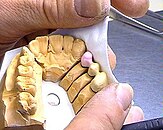Bridge (dental technology)
In dentistry, a bridge is understood to be a denture that is supported exclusively on teeth , tooth roots or dental implants - also called anchors. The name bridge comes from the fact that this type of tooth replacement bridges one or more tooth gaps with artificial teeth . The artificial teeth are connected to the bridge abutments (also called anchors), tooth crowns or partial crowns . As a rule, a bridge is fixed, i.e. permanently cemented. If telescopic crowns are used as anchors, such a bridge can also be removable. In the case of bridge dentures, the pillars are also referred to as fixing elements and the pontics as bridge bodies or bridge elements that replace the missing teeth. The usability of abutment teeth as bridge anchors depends on the value of the abutments .
variants
If there is a single bridge body between the bridge piers, it is a single-span bridge; if there are several bridge bodies, it is a multi-span bridge (see illustration below left). In exceptional cases, a bridge pontic can also be attached to the end of a bridge pillar (floating). This construction is called a cantilever or extension bridge.
In the case of an adhesive bridge (also: adhesive or Maryland bridge), the bridge anchors do not consist of crowns, but of metallic supports that are glued to the minimally ground abutment teeth on the invisible side using the enamel etching technique and composite (plastic).
Dental technology of the bridge
The load-bearing part of a bridge, the bridge framework, is usually made of a gold or non-precious metal alloy (NEM). If this is coated with a fired ceramic mass, one speaks of a veneering ceramic bridge (VMK) or a composite ceramic bridge. Aesthetically very good results can be achieved through ceramic veneering.
Since the year 2000 there have been bridges made of zirconium dioxide (in technical jargon also wrongly called zirconium) and all-ceramic bridges , which have sufficient stability without a metallic framework. In the complex production of these bridges, a bridge framework is milled out of a ceramic block under computer control and coated with a special ceramic compound.
Finished ceramic veneer from the palatal ; The surface is still rough - the final glaze firing follows.
Finished ceramic veneer from the vestibular area .
Individual evidence
- ^ Walter Hoffmann-Axthelm : Lexicon of dentistry. Quintessenz-Verlag, Berlin.
- ↑ Reinhard Marxkors: Textbook of dental prosthetics . Deutscher Ärzteverlag, 2007, ISBN 978-3-7691-3353-0 , p. 75- ( google.com ).
- ^ Crowns and bridges Swiss Dental Society SSO
- ↑ B. Al-Amleh, K. Lyons, M. Swain: Clinical trials in zirconia: a systematic review. In: J Oral Rehabil . 37, 2010, pp. 641-652.
- ↑ VC Bachhav, MA Aras Zirconia-based fixed partial dentures: a clinical review. In: Quintessence Int. 42, 2011, pp. 173-182.








